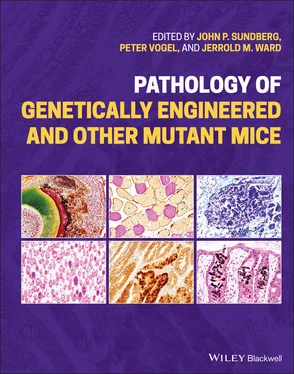Pathology of Genetically Engineered and Other Mutant Mice
Здесь есть возможность читать онлайн «Pathology of Genetically Engineered and Other Mutant Mice» — ознакомительный отрывок электронной книги совершенно бесплатно, а после прочтения отрывка купить полную версию. В некоторых случаях можно слушать аудио, скачать через торрент в формате fb2 и присутствует краткое содержание. Жанр: unrecognised, на английском языке. Описание произведения, (предисловие) а так же отзывы посетителей доступны на портале библиотеки ЛибКат.
- Название:Pathology of Genetically Engineered and Other Mutant Mice
- Автор:
- Жанр:
- Год:неизвестен
- ISBN:нет данных
- Рейтинг книги:3 / 5. Голосов: 1
-
Избранное:Добавить в избранное
- Отзывы:
-
Ваша оценка:
- 60
- 1
- 2
- 3
- 4
- 5
Pathology of Genetically Engineered and Other Mutant Mice: краткое содержание, описание и аннотация
Предлагаем к чтению аннотацию, описание, краткое содержание или предисловие (зависит от того, что написал сам автор книги «Pathology of Genetically Engineered and Other Mutant Mice»). Если вы не нашли необходимую информацию о книге — напишите в комментариях, мы постараемся отыскать её.
An updated and comprehensive reference to pathology in every organ system in genetically modified mice Pathology of Genetically Engineered and Other Mutant Mice
Pathology of Genetically Engineered and Other Mutant Mice
Pathology of Genetically Engineered and Other Mutant Mice — читать онлайн ознакомительный отрывок
Ниже представлен текст книги, разбитый по страницам. Система сохранения места последней прочитанной страницы, позволяет с удобством читать онлайн бесплатно книгу «Pathology of Genetically Engineered and Other Mutant Mice», без необходимости каждый раз заново искать на чём Вы остановились. Поставьте закладку, и сможете в любой момент перейти на страницу, на которой закончили чтение.
Интервал:
Закладка:
Hypoplasia and aplasia: Mutations or chemical treatments that induce DNA damage or interfere with cell division will induce bone marrow aplasia, a general loss of all hematopoietic lineages. Hematopoietic cells are absent, and bone marrow space is filled with venous sinuses and a few adipocytes ( Figure 7.1). Such changes are often associated with a reduction of the red pulp of the spleen. Loss of specific lineages may be seen with genetic deletion of growth factors. A selective decrease of erythropoiesis is associated with chronic inflammation. There is increased myelopoiesis and an increase of hemosiderin.
Hyperplasia: Increased numbers of hematopoietic cells may involve all or selected cell lineages. The hyperplasia is usually the result of increased demand induced by increased secretion of growth factors or cytokines, and is typically associated with increased extramedullary hematopoiesis (EMH) in the spleen and liver. An increase of erythropoiesis is caused by anemia and may be associated with megakaryocyte hyperplasia if there is loss of platelets. Increased myelopoiesis is often seen with chronic inflammation and can result in a dramatic shift of the myeloid:erythroid ratio. Figure 7.1 Bone marrow. Bone marrow hypoplasia four days after deletion of Cul4A in Cul4a/Pcid2tm2Ktc mice (b) compared with C57BL/6J mice (a). (c) Fibro‐osseous lesions in 821‐day old female 129S1/SvlmJ and 427‐day old female KK/H1J (d) mice. Higher magnification of fibro‐osseous lesion (e).
Aging‐associated changes: The overall cellularity of the bone marrow in old mice remains high at >90% in contrast to humans in which the hematopoietic cells are gradually replaced by adipocytes, although there are strain and regional differences in the distribution and accumulation of adipocytes. Aging is associated with an increased number of HSCs, increased myelopoiesis, and increased accumulation of plasma cells. The plasma cells promote myelopoiesis through the local secretion of inflammatory cytokines [6]. These changes may be difficult to assess in routine H&E sections of the bone marrow. Fibro‐osseous lesions are proliferative alterations comprised of fibrovascular tissue intermixed with fine bone trabeculae in the bone marrow of aged mice ( Figure 7.1). Although they replace hemopoietic tissue, the lesions are not sufficiently expansive to compromise the production of hemopoietic cells. Fibro‐osseous lesions occur predominantly in female mice with a high incidence in B6C3F1 mice and in certain inbred strains including 129S1/SvImJ, KK/H1J, and NZW/LacJ [7–9].
Lymphoid Tissues
Lymphoid tissue can be divided into primary, secondary, and tertiary lymphoid tissues. The primary lymphoid organs are the sites of development and maturation of B and T lymphocytes. The developing B and T lymphocytes undergo somatic recombination of the immunoglobulin and T cell receptor gene segments resulting in a vast repertoire of antigen‐specific receptors. This process is largely antigen‐independent. The primary lymphoid organs in the mouse are the bone marrow for B cell development and the thymus for T cell development. The initiation of the adaptive immune response mediated by antibodies and T cells occurs in the secondary lymphoid organs which include the lymph nodes, white pulp of the spleen, and mucosa‐associated lymphoid tissues. Mature, naïve B and T lymphocytes circulate through the secondary lymphoid organs which are connected via the lymphatic and blood circulation. Naïve lymphocytes enter the lymph nodes and mucosa‐associated lymphoid tissues via high endothelial venules and leave via the efferent lymphatics. The spleen has open‐ended arterioles that deliver lymphocytes to the marginal zone and red pulp. Lymphocytes leave the spleen primarily via the splenic vein. The restricted circulation pattern of naïve lymphocytes maximizes the chances that the few lymphocytes with receptors for a specific antigen will encounter that antigen which is delivered to the lymphoid tissues. Lymph nodes are strategically positioned throughout the body to capture antigens delivered via the afferent lymphatics from the tributary areas. Blood‐borne antigens are captured by macrophages, B cells and dendritic cells in the marginal zone of the spleen and transported into the white pulp. The epithelium that overlies the mucosa‐associated lymphoid tissues has specialized epithelial cells (M cells) that facilitate the uptake of antigens from the mucosal surface and transport them into the underlying lymphoid tissue.
Tertiary lymphoid organs develop at sites of chronic inflammation associated with infections, autoimmune disease, and cancer. The organization of tertiary lymphoid organs mimics that of secondary lymphoid organs with varying degrees of differentiation.
Primary Lymphoid Organs
The primary lymphoid organs in the mouse are the bone marrow for the antigen‐independent generation of B cells and the thymus for T cells. The general assessment of bone marrow is described above. Microscopy of routinely stained sections of bone marrow does not provide specific information about the development of B cells. This requires isolation of bone marrow cells followed by labeling with appropriate reagents and analysis by flow cytometry.
Thymus
The thymus is a bi‐lobed organ in the cranial mediastinum of the thoracic cavity. It is composed of a network of epithelial cells filled with developing T cells (“thymocytes”) and fewer other hemopoietic cells. The epithelial cells are derived from the endoderm of the third pharyngeal pouch. The formation of the thymus starts around ED 11, and the initial population of the thymus by hemopoietic cells begins at ED 12. Under the influence of the transcription factor FOXN1, thymic epithelial precursor cells differentiate into cortical and medullary epithelial cells [10]. The cortex of the thymus is densely populated with immature T cells which obscure the presence of the cortical epithelial network on H&E sections. Macrophages containing apoptotic fragments of immature T cells (“tingible body macrophages”) are scattered throughout the cortex. The medulla is less densely populated with more mature T cells intermixed with macrophages, dendritic cells, B cells, and eosinophils. The medullary epithelial cells are plump with more cytoplasm compared with the dendritic morphology of the cortical epithelial cells. Medullary epithelial cells undergo a maturation process and undergo cornification upon terminal differentiation. Hassall's (thymic) corpuscles are clusters of cornified epithelial cells that are typical of the thymic medulla. They are not as well organized and less prominent in commonly used strains of mice such as C57BL/6 and BALB/c as in humans and many other mammals. However, certain mouse strains including NZW/LacJ and NZBW F1 mice have many Hassall's corpuscles [11] ( Figure 7.2).

Figure 7.2 Thymus. (a, b). Medulla of thymus of a female C57BL/6J mouse (a) and a female NZW/LacJ mouse with prominent Hassall's corpuscles (b). (c) Cyst in thymus of a 24‐week old CBA/2J mouse. (d) Cystic remnant in FOXN1‐deficient NU/J mouse. Inset: higher magnification of ciliated epithelial cells.
Cervical thymus tissue may be found in up to 90% of mice depending on the genetic background. These are likely derived from remnants of thymic embryonal tissues that are left behind during the migration of primordial thymus from the pharyngeal region to the cranial mediastinum. The morphology ranges from small clusters of lymphocytes to well‐differentiated tissue with a distinct medulla and cortex typical of the thymus.
Читать дальшеИнтервал:
Закладка:
Похожие книги на «Pathology of Genetically Engineered and Other Mutant Mice»
Представляем Вашему вниманию похожие книги на «Pathology of Genetically Engineered and Other Mutant Mice» списком для выбора. Мы отобрали схожую по названию и смыслу литературу в надежде предоставить читателям больше вариантов отыскать новые, интересные, ещё непрочитанные произведения.
Обсуждение, отзывы о книге «Pathology of Genetically Engineered and Other Mutant Mice» и просто собственные мнения читателей. Оставьте ваши комментарии, напишите, что Вы думаете о произведении, его смысле или главных героях. Укажите что конкретно понравилось, а что нет, и почему Вы так считаете.












